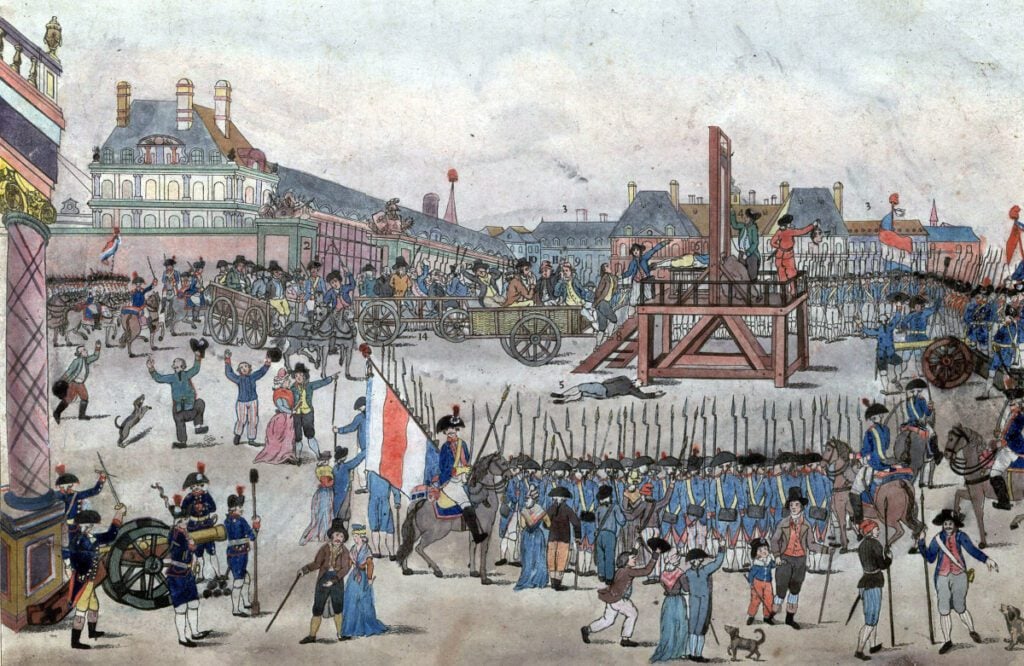The guillotine was particularly designed to carry out executions efficiently. It consisted of a tall frame with a weighted blade that was suspended at the top. But did you know that the device was so popular in the 1970s that toy replicas were made for children to play with?
The Guillotine was so famous in the 1790s that toy replicas were sold to children to behead their dolls and rodents, and the wealthy had tiny ones on their dining table for slicing bread.
When Did Guillotines Rise in Popularity?
The term guillotine was popularized in the 1790s during the French Revolution, but similar execution machines had existed centuries before.
The English possessed a sliding ax known as the Halifax Gibbet that may have been used to chop off heads as far back as antiquity, while the Middle Ages saw the use of a beheading tool called the planke in Germany and Flanders.
The Italian mannaia from the Renaissance and the infamous Scottish Maiden, which claimed the lives of some 120 individuals between the 16th and 18th centuries, are two previous devices that are thought to have inspired the French Guillotine. Evidence suggests that early guillotines may have been used in France even before the French Revolution. (Source: History)
The Guillotine was Invented for a More Humane Way of Execution
Dr. Joseph-Ignace Guillotin first suggested that the French government use a more humane means of death in late 1789 when the French Guillotine first appeared. Guillotin felt that a lightning-quick machine rather than a sword and axe beheading, which frequently went wrong, would be more humanitarian and egalitarian even if he despised the death penalty.
Later, he assisted in directing the creation of the prototype, a formidable instrument created by the French physician Antoine Louis and constructed by the German harpsichord craftsman Tobias Schmidt. To the horror of its alleged creator, the tool claimed its first recorded victim in April 1792 and rapidly earned the moniker guillotine. During the guillotine panic of the 1790s, Guillotin attempted to dissociate himself from the device. Later, in the early 19th century, his family unsuccessfully petitioned the French government to rename the device. (Source: History)
Why Do Guillotine Executions Attract a Lot of Spectators?
The Guillotine executed numerous enemies of the French revolution during the Reign of Terror in the mid-1790s. When the machine started, some public members complained that it was too swift and clinical, but the process soon transformed into great entertainment.
Numerous songs, jokes, and poems were written praising the Guillotine, which attracted large crowds of spectators to the Place de la Revolution to witness its gruesome operation. The adjoining Cabaret de la Guillotine restaurant offered short bites for patrons in addition to souvenirs and a program containing the victims’ names.
Some people went daily, most notably the Tricoteuses, a group of morbid women who were said to have sat by the scaffold and knitted while people were beheaded. Even the condemned were accommodated in the theater. Before being executed, many victims made scathing remarks or said obstinate last words, while others danced their way up the scaffold. At the end of the 18th century, (Source: History)
When Did They Make Toy Replicas of the Guillotine?
Children frequently witnessed public executions by the Guillotine, and some may have even played with their toy guillotines at home. A two-foot-tall duplicate blade-and-timbers was a well-liked toy in France in the 1790s. Some municipalities outlawed fully functional guillotines because children would use them to decapitate dolls or even tiny mice. A few upper-class dining tables also had novelty guillotines to chop bread and vegetables. (Source: History)
